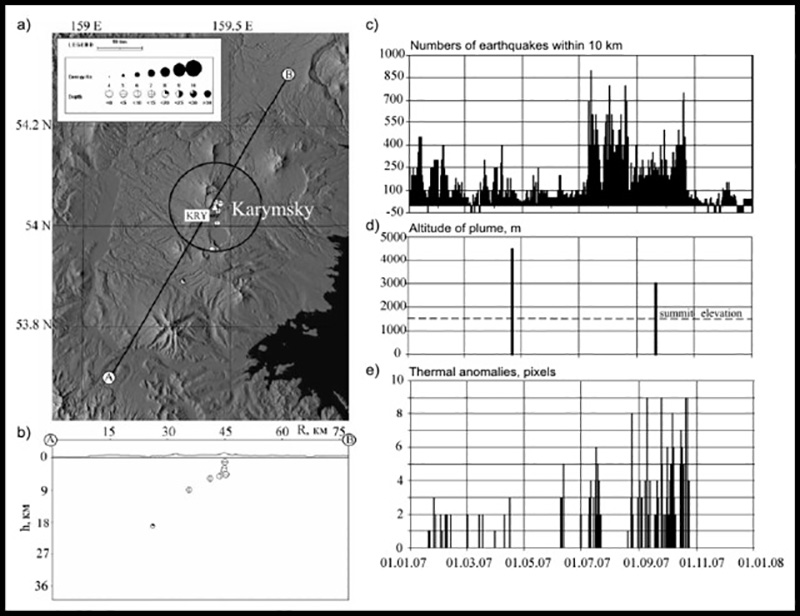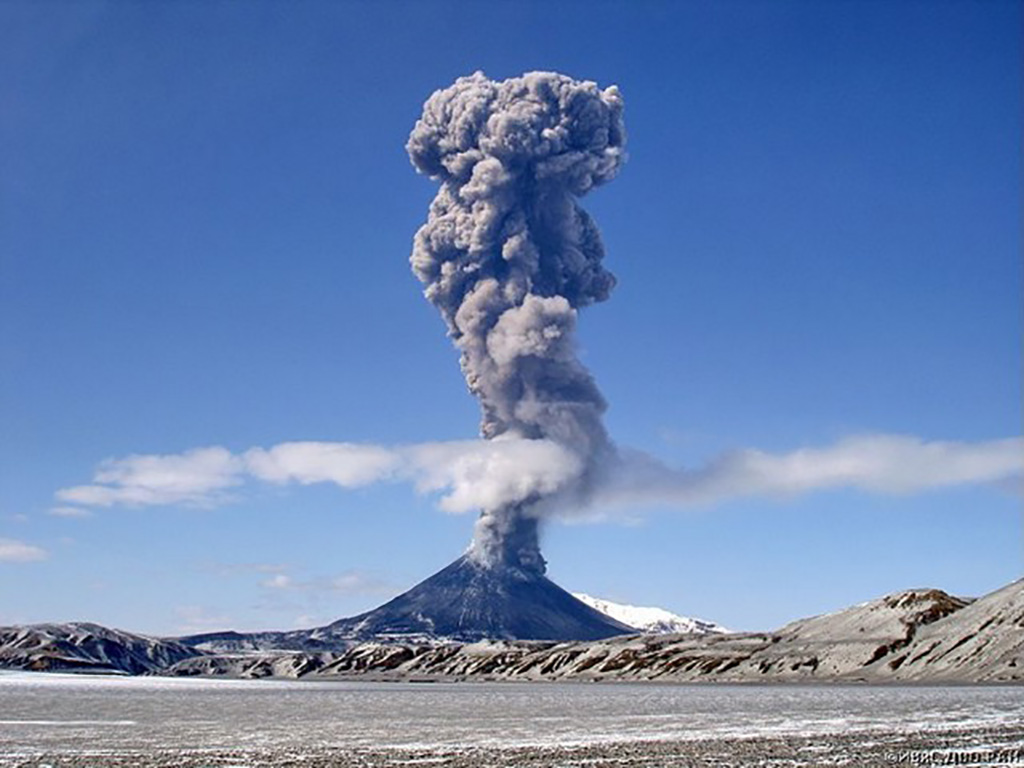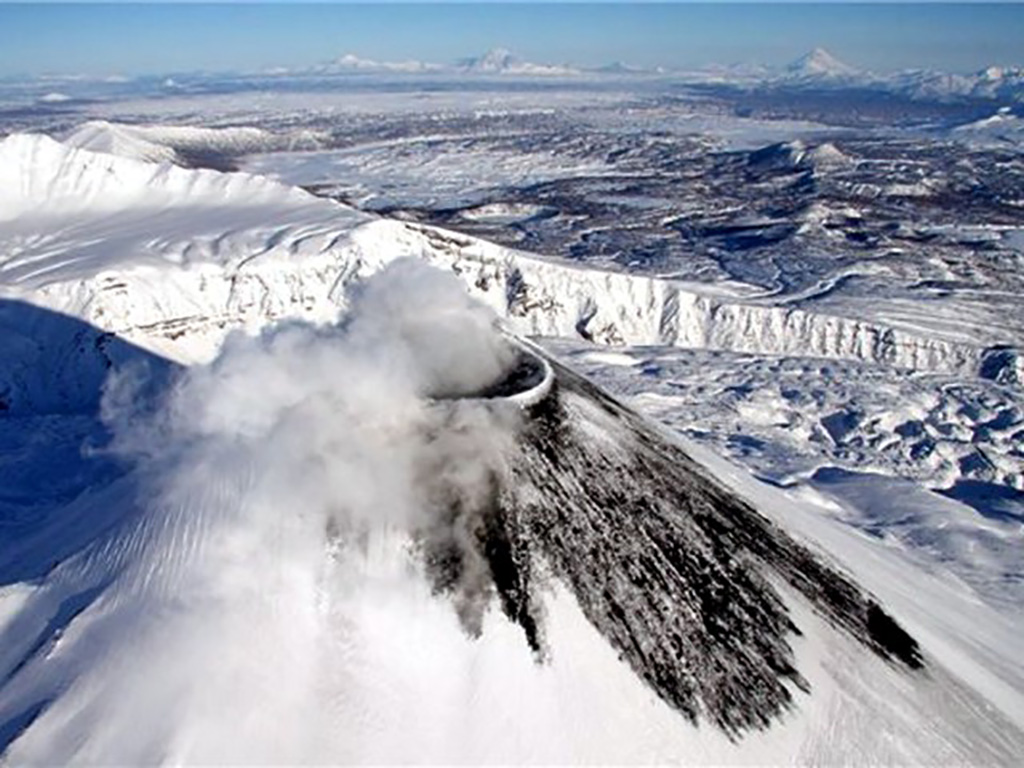Report on Karymsky (Russia) — December 2008
Bulletin of the Global Volcanism Network, vol. 33, no. 12 (December 2008)
Managing Editor: Richard Wunderman.
Karymsky (Russia) Ash plumes during 2007-January 2009, one over 450 km long
Please cite this report as:
Global Volcanism Program, 2008. Report on Karymsky (Russia) (Wunderman, R., ed.). Bulletin of the Global Volcanism Network, 33:12. Smithsonian Institution. https://doi.org/10.5479/si.GVP.BGVN200812-300130
Karymsky
Russia
54.049°N, 159.443°E; summit elev. 1513 m
All times are local (unless otherwise noted)
This report summarizes activity at Karymsky from February 2007 to 23 January 2009, with the exclusion of June-September 2008 (figure 16), when activity was variable (BGVN 33:07). During the reporting interval the Level of Concern Color Code remained at Orange. Overall activity during 2007 was also variable, but increased during July-December 2007 (figure 17).
 |
Figure 16. Recent Karymsky reporting in the Bulletin (shaded areas) and the gaps in coverage discussed in this report. |
During February to April 2007, activity was characterized by constant ash explosions and steam-and-gas emissions. Thermal anomalies were detected, and plumes rose to altitudes of 2.5-5.0 km before drifting NW, N, NE, E, and SE (figure 18).
During May 2007 the volcano quieted; activity was characterized by low steam-and-gas emissions. There was increased seismicity in July-October 2007, with a daily high of 900 events in mid-July. During 21-27 September ash plumes extended over 450 km E, and on 5, 7, and 8 October ash plumes that rose to 30 km altitude drifted E and NE. Activity decreased after November, but steaming was evident (figure 19).
During March-April 2008 explosive activity again increased. On 15-16 March an ash plume drifted 40 km to the SE, and ash deposits were noted 15-20 km to the NE and ESE of the summit. On 3 April ash deposits were noted in areas about 20 km to the E, 70 km to the SW, and 45-50 km to the S. On 8 April an ash plume drifted 70-80 km ESE.
On 11 October 2008 an ash plume rose to an altitude of 3.4 km, and on 13 October a 5-km-wide ash plume drifted 32 km NNE. On 2 November an ash plume rose to an altitude of 4 km. On 10 November an ash plume drifted 38 km E, and 28 km ENE. On 15 November an ash plume extended 28 km to the E. On 8 December ash plumes rose to altitudes of 2 km and ash deposits on the E flank were more than 5 km long. On 16 December an ash plume extended 240 km to the SE and ESE. During 21-23 December ash plumes extended about 80 km to the E. Ash deposits were noted on 21 December; the deposits extended 26 km SE and 9 km NE.
As late as 8 and 12 January 2009, gas-and-steam plumes extended about 25 km to the SE and NE. The Tokyo VAAC reported that on 16 January an ash plume rose to an altitude of 3.7 km and drifted SE. Analysis of satellite imagery revealed a thermal anomaly in the crater during 18-19 and 21 January 2009.
Reference. Senyukov, S.L., Droznina, S.Y., Nuzhdina, I.N., Garbuzova, V.T., Kozhevnikova, T.Y., Toloknova, S.L., and Sobolevskaya, O.V., 2008, Monitoring of active Kamchatkan volcanoes using remote methods in 2007: Conference proceedings, dedicated to the day of volcanologists, on 27-29 March, 2008, Petropavlovsk-Kamchatsky: IViS FED RAN, 329 p. (in Russian).
Geological Summary. Karymsky, the most active volcano of Kamchatka's eastern volcanic zone, is a symmetrical stratovolcano constructed within a 5-km-wide caldera that formed during the early Holocene. The caldera cuts the south side of the Pleistocene Dvor volcano and is located outside the north margin of the large mid-Pleistocene Polovinka caldera, which contains the smaller Akademia Nauk and Odnoboky calderas. Most seismicity preceding Karymsky eruptions originated beneath Akademia Nauk caldera, located immediately south. The caldera enclosing Karymsky formed about 7600-7700 radiocarbon years ago; construction of the stratovolcano began about 2000 years later. The latest eruptive period began about 500 years ago, following a 2300-year quiescence. Much of the cone is mantled by lava flows less than 200 years old. Historical eruptions have been vulcanian or vulcanian-strombolian with moderate explosive activity and occasional lava flows from the summit crater.
Information Contacts: Kamchatka Volcanic Eruptions Response Team (KVERT), Institute of Volcanology and Seismology (IV&S) Far East Division, Russian Academy of Sciences (FED RAS); Kamchatka Branch of the Geophysical Service of the Russian Academy of Sciences (KB GS RAS), Piip Ave. 9, Petropavlovsk-Kamchatsky, 683006, Russia (URL: http://www.kscnet.ru/ivs, http://www.emsd.ru/~ssl/monitoring/main.htm); Alexander Sokorenko, IV&S; Tokyo Volcanic Ash Advisory Center (VAAC), Tokyo, Japan (URL: http://ds.data.jma.go.jp/svd/vaac/data/).




